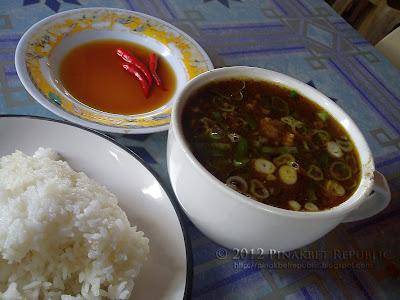 |
| Really bitter Ilokano pinapaitan, its broth/soup thickened not with fat but with pespes boiled for hours. |
Pinapaitan is solely and authentic – even exotic
– Ilokano dish. Loved by any true-blue Ilokano there is, specially those bred in the
away (farm, country sides) or
promdi (from the province) in any Ilocos place, native and even those so-called "Ilokanized". Well, some Ilokanos shun it, but it’s really an acquired taste and kind of inherent preference if you really have Ilokano roots or blood. But
pinapaitan has become a truly Philippine – national, that is – dish. Ilokanos and non-Ilokanos loved it, period. Although non-Ilokanos has somewhat corrupted the right term into a lame
“papaitan” (Tagalogized, perhaps?). And most non-Ilokano variation of the original is not at all bitter.
Bitterness defines the Ilokano palate, and that of being Ilokano, and the distinct Ilokano-ness (mistaken by some as being
kuripot or tightwad, big deal). Some pathetic "
papaitan” has no
pait at all simply because they avoid the extreme
pait of it, bile or the
pespes (extract of the masticated grass inside the small intestines of the cow/goat/carabao). And they have the gall to call it
papaitan still when it’s not that bitter! IMHO, a certain meat soup or stew even with some innards in it should not be called a
"pinapaitan" or
"papaitan" if it's not bitter because it's an insult to the term or name itself, ahem!
So, here are real Ilokano pinapaitans, the bitter ones!
 |
| An early bird catches the "pers klas" cuts (the choicest pinapaitan/kappukan cuts). This is the prize of an early foray into the slaughterhouse mismo, having the freshest cuts. |
 |
The prizey and pricey beef innards/offal: heart, liver, intestines, the tripes–the liblibro and the tualtualia, and the most important pespes (intestine "juice").
|
 |
| Sometimes when you're late to have your pang-pinapaitans, you'll just content yourself with this standard: tripes and some meat and an intestines cut filled with ready pespes. |
 |
| Cutting up... |
 |
| The tualtualia (literally "towel") being cut into bite pieces... |
Cooking the perfect Ilokano
pinapaitan entails a lot of labor and love. After a painstaking preparation of cutting up the meat and offal into bite pieces and chopping the onions and crushing garlics and gingers, ready yourself to boil them oil to its bittery goodness. First, you'll have to
sautée the spices together with the cut pieces to enhance flavor and aroma and to do away some unwanted smell. Then the boiling and simmering. You have two options: a medium rare, or a very tender
pinapaitan. A medium rare
pinapaitan is like having an
imbaliktad but with soup or lots of broth, the cooking/boiling is brief so the meat and innards is just chewable and not tough. A tenderized
pinapaitan, which I prefer, is slowly boiled/simmered for an hour or more (you can opt to use a pressure cooker if you want it quickly done), and as a result will give out more flavor and color and aroma.
 |
| A perfectly cooked pinapaitan, simmered for hours to really tenderize the meat and innards, with its sweetishly bitter fat oozing out to tantalize a finicky Ilokano palate. |
 |
| A really napait a pinapaitan. Even with its thick soup only, I'll be contented with my steamed rice. (Photo from Ilokano Food) |
More finds enjoyed along way on my quest for a real bitter pinapaitan:
 |
| From a popular pinapaitan/lauya house just beside the slaughterhouse in Capatan, Tuguegarao City. |
 |
| Pinapaitan at a roadside eatery along the national highway in Carig, Tuguegarao City. Pinapaitan's real pait essence is more intensified by spicing it up with lots of chili. |
 |
| Home-cooked pinapaitan, simmered for hours. |
 |
| My plateful of pinapaitan with fermented chili on the side. |
:::::





























PLEASE DO MAKE A LIST OF ALL THE INGREDIENTS AND PROCEDURES ON HOW TO COOK IT.. TAHNK YOU
ReplyDeleteThe original one.... all others are distant second.
ReplyDeletePlease can you sending me the recipe
ReplyDelete